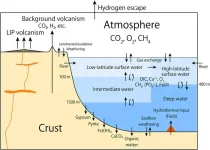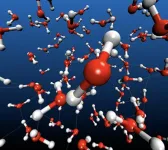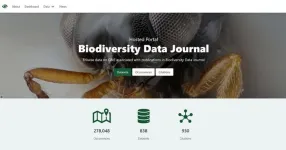(Press-News.org)
It is widely believed that Earth’s atmosphere has been rich in oxygen for about 2.5 billion years due to a relatively rapid increase in microorganisms capable of performing photosynthesis. Researchers, including those from the University of Tokyo, provide a mechanism to explain precursor oxygenation events, or “whiffs,” which may have opened the door for this to occur. Their findings suggest volcanic activity altered conditions enough to accelerate oxygenation, and the whiffs are an indication of this taking place.
Take a deep breath. Do you ever think about the air entering your lungs? It’s mostly inert nitrogen, and the valuable oxygen our lives depend on only accounts for 21%. But this hasn’t always been the case; in fact, several mass extinction events correspond to times when this figure changed dramatically. And if you go back far enough, you’ll find that before about 3 billion years ago, there was hardly any oxygen at all. So what changed, and how did it happen?
The scientific consensus is that about 2.5 billion years ago, the Great Oxygenation Event (GOE) took place, most likely due to a proliferation of microorganisms exploiting favorable conditions and facing little competition. They would have essentially converted the carbon dioxide-rich atmosphere into an oxygen-rich one, and following that came complex life, which favored this new abundance of oxygen. But it seems there were some precursor oxygenation events prior to the GOE that may indicate the exact nature and timing of changes in the conditions necessary for the GOE to begin.
“Activity of microorganisms in the ocean played a central role in the evolution of atmospheric oxygen. However, we think this would not have immediately led to atmospheric oxygenation because the amount of nutrients such as phosphate in the ocean at that time was limited, restricting activity of cyanobacteria, a group of bacteria capable of photosynthesis,” said Professor Eiichi Tajika from the Department of Earth and Planetary Science at the University of Tokyo. “It likely took some massive geological events to seed the oceans with nutrients, including the growth of the continents and, as we suggest in our paper, intense volcanic activity, which we know to have occurred.”
Tajika and his team used a numerical model to simulate key aspects of biological, geological and chemical changes during the late Archean eon (3.0-2.5 billion years ago) of Earth’s geologic history. They found that large-scale volcanic activity increased atmospheric carbon dioxide, thereby warming the climate, and increased nutrient supply to the ocean, thus feeding marine life, which in turn temporarily increased atmospheric oxygen. The increase in oxygen was not very steady, though, and came and went in bursts now known as whiffs.
“Understanding the whiffs is critical for constraining the timing of the emergence of photosynthetic microorganisms. The occurrences are inferred from concentrations of elements sensitive to atmospheric oxygen levels in the geologic record,” said visiting research associate Yasuto Watanabe. “The biggest challenge was to develop a numerical model that could simulate the complex, dynamic behavior of biogeochemical cycles under late Archean conditions. We built upon our shared experience with using similar models for other times and purposes, refining and coupling different components together to simulate the dynamic behavior of the late-Archean Earth system in the aftermath of the volatile volcanic events.”
###
Journal article:
Yasuto Watanabe, Kazumi Ozaki, Mariko Harada, Hironao Matsumoto & Eiichi Tajika, “Mechanistic links between intense volcanism and the transient oxygenation of the Archean atmosphere”, Communications Earth & Environment, DOI: 10.1038/s43247-025-02090-x, https://doi.org/10.1038/s43247-025-02090-x
Funding: This work is supported by Grant-in-aid for JSPS KAKENHI Grants Number 24H00267 (K.O.), and JST FOREST Program (Grant JPMJFR2274, Japan) (K.O.).
Useful links:
Department of Earth and Planetary Science - https://www.eps.s.u-tokyo.ac.jp/en/
Graduate School of Science - https://www.s.u-tokyo.ac.jp/en/index.html
Research contact:
Professor Eiichi Tajika
Department of Earth and Planetary Science, The University of Tokyo,
7-3-1 Hongo, Bunkyo-ku, Tokyo, 113-0033, Japan
tajika@eps.s.u-tokyo.ac.jp
Press contact:
Mr. Rohan Mehra
Public Relations Group, The University of Tokyo,
7-3-1 Hongo, Bunkyo-ku, Tokyo, 113-8656, Japan
press-releases.adm@gs.mail.u-tokyo.ac.jp
About The University of Tokyo:
The University of Tokyo is Japan's leading university and one of the world's top research universities. The vast research output of some 6,000 researchers is published in the world's top journals across the arts and sciences. Our vibrant student body of around 15,000 undergraduate and 15,000 graduate students includes over 4,000 international students. Find out more at www.u-tokyo.ac.jp/en/ or follow us on X (formerly Twitter) at @UTokyo_News_en.
END
Water is unique. It is one of the only substances that can exist in nature as a solid, liquid and gas at the same time under ambient conditions (think of solid ice over a pond, which is liquid underneath while storm clouds float overhead). It is also one of the only substances whose solid form is less dense than its liquid — this is why ice floats.
Now scientists from the University of California San Diego have uncovered a key finding to another unique property: at high pressure and low temperature, liquid water separates into two distinct liquid phases — one high-density ...
The Biodiversity Data Journal (BDJ) became the second open-access peer-reviewed scholarly title to make use of the hosted portals service provided by the Global Biodiversity Information Facility (GBIF): an international network and data infrastructure aimed at providing anyone, anywhere, open access to data about all types of life on Earth.
The Biodiversity Data Journal portal, hosted on the GBIF platform, is to support biodiversity data use and engagement at national, institutional, regional and thematic scales by facilitating access and reuse of data by users with various expertise ...
Gene mutations caused by exposure to certain chemical compounds have been linked to the development of gliomas, the most common type of malignant brain tumor. New research reveals that among patients with gliomas, these mutations are more common in firefighters than in individuals with other occupations. The findings are published by Wiley online in CANCER, a peer-reviewed journal of the American Cancer Society.
The gene mutations of interest in this study make up a mutational pattern or “signature” that other investigators previously associated with exposure to haloalkanes, which ...
With soaring egg prices and ongoing bird flu headlines, many parents are uncertain about the risks and facts surrounding the virus, a national poll suggests.
Most parents say they don’t know if there have been cases of bird flu in their state, and less than half feel that they are able to find accurate and current information about it, according to the University of Michigan Health C.S. Mott Children’s Hospital National Poll on Children’s health.
“Many parents may hear about bird flu in the news but don’t feel well-informed or know if they should be taking action to protect their families,” said Mott Poll Co-Director Sarah Clark, M.P.H.
“This ...
A University of Oxford study has determined that the widely used tools available to businesses for assessing their biodiversity impacts depend on broad assumptions and can have large uncertainties that are poorly understood or communicated. If used appropriately, they can be powerful tools to help guide effective action to address biodiversity loss – but if not, they can lead to misguided effort and can be insufficient for robust biodiversity strategy design.
Businesses across a range of industries and sectors are under growing pressure to develop biodiversity strategies that not only minimise their negative impacts but ...
Politicians learned this lesson a long time ago: a well-placed joke is a valuable tool for capturing public attention and building trust. Scientists, however, are much more reluctant to use humor when engaging in science communication. They may fear that a lighthearted approach could make them seem less authoritative and, consequently, make scientific findings appear less credible.
The good news, however, is that science itself seems to contradict this assumption. A new study led by Alexandra Lynn Frank, a ...
Krapivsky drew inspiration from the famous “secretary problem” or “optimal marriage problem”. In one of its many versions, a princess must choose her future husband from a pool of 100 candidates at a grand reception. However, strict rules apply: she may meet only one suitor at a time and has limited time to get to know him. At the end of each encounter, she must decide immediately whether to accept or reject the suitor. She cannot revisit previous candidates, nor can she ask any of them to wait while she considers others. How can the princess hope to make the best choice?
The secret lies in a number: 37, to be precise (raise your hand if you ...
High demand for eel combined with decline in stock have resulted in soaring prices for this food item, which in many cultures, is considered a delicacy. This has fuelled a concern globally as the prized food item is now being illegally traded from Europe to Asia.
Current research has focused on the critically endangered Anguilla anguilla, commonly known as the European eel. While its export outside the European Union is tightly regulated, large quantities of A. anguilla juveniles continue to be smuggled ...
Next-generation imaging technology is rapidly expanding beyond smartphones into intelligent devices, robotics, extended reality (XR) devices, healthcare, CCTV, and various other industries. At the core of these technological advances are highly efficient, ultra-compact image sensors that convert light signals into electrical signals. Image sensors capture and process visual information from objects and environments, enabling precise reconstruction of their shape, size, and spatial position.
Currently, commercial image sensors are primarily based on silicon semiconductors. ...
A new study examining the effects of sleep patterns and shift work on the immune system has found that sleep debt and night shifts increase the risk of several common infections in nurses.
Modern society relies on shift work, which requires employees to work outside of traditional hours. While essential in sectors such as healthcare, growing evidence suggests that these work patterns may negatively impact worker’s health.
This study, which analysed self-reported data from 1,335 Norwegian nurses, found that shift work – particularly night shifts – was associated with a higher risk of several infections, including the ...





